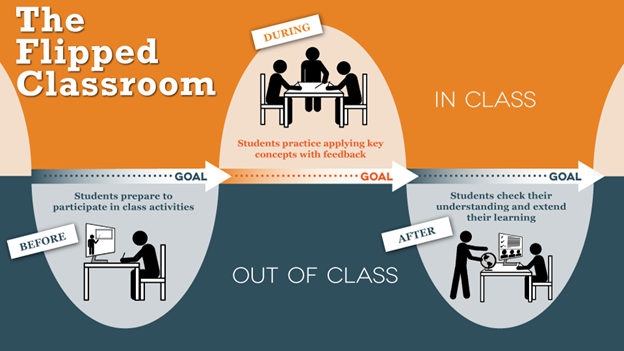By Dr. Erin Bell, CETL Contributor
While the concept of the flipped classroom has been present in conversations regarding effective teaching for years (if not decades) ambiguity remains about what flipping a classroom means and how to do this effectively.
Simply put, flipping the classroom means that the educator assigns certain duties to be completed outside of class so that the in-class meeting time can be utilized effectively and actively. As McLaughlin et al. (2014) note, class time includes “active learning exercises, such as teamwork, debates, self-reflection, and case studies, that prompt students’ engagement and reflection encourage them to explore attitudes and values while fostering their motivation to acquire knowledge and enhance skills.” During class, instructors may also use quizzes, reflection questions, or other low-stakes assessments to gauge students’ readiness to work with the content.
In this flipped classroom model, the instructor is essentially offloading some of the preparatory work to be completed outside of class so that class time (either for in-person or synchronous online classes) can be utilized for maximum learning. Rather than spending 25 minutes providing an overview of assignment directions and parameters during a class session, a professor can assign a video overview of the assignment for students to watch outside of class. To ensure students watch the video, the instructor could post the video to the YuJa Media Library tool and embed quiz questions as checkpoints to make sure students are fully prepared for the in-class work.
Thus, class time can be dedicated to deeper learning and problem-solving. This approach allows for more personalized learning and real-time feedback, and as McLaughlin et al. (2014) further explains, significantly, the model is student-centered. As they note, “each student is responsible for coming to class with a basic understanding of the material, so that she or he can fully participate and engage in class discussion. Content acquisition then is self-paced and self-guided, enabling students to control when and how much content they view.”
As in other student-centered models, in a flipped classroom the instructor still must serve as a facilitator, leading students through the preparatory content and the in-class activities. Such “rich, open-ended experiences within the classroom equip students for success by fostering critical cognitive development and promoting innovation through collaboration” (McLaughlin et al., 2014).

Benefits of Flipping the Classroom
- Active Learning: Students are actively engaging with material rather than passively listening to lectures.
- Improved Comprehension: By applying knowledge in real time, students are more likely to deepen their understanding of complex concepts.
- Personalized Support: Instructors have more time to offer individualized help and clarification during class.
- Peer Learning: Collaborative activities enable students to learn from and with their peers, enhancing engagement.
Challenges of a Flipped Classroom
- Student Accountability: Students must be motivated to complete the pre-class work; otherwise, they may come to class unprepared.
- Instructor Preparation: Flipping the classroom often requires significant planning to ensure that both pre-class content and in-class activities are aligned and effective.
Reference the following resources for more information about flipped classrooms:
Bredow, C. A., Roehling, P. V., Knorp, A. J., & Sweet, A. M. (2021). To flip or not to flip? A meta-analysis of the efficacy of flipped learning in higher education. Review of Educational Research, 91(6), 878–918. https://doi.org/10.3102/00346543211019122
Cornell University Center for Teaching Innovation. (n.d.). Flipping the classroom. Retrieved February 11, 2025, from https://teaching.cornell.edu/teaching-resources/active-collaborative-learning/flipping-classroom
McLaughlin, J. E., Roth, M. T., Glatt, D. M., Gharkholonarehe, N., Davidson, C. A., Griffin, L. M., Esserman, D. A., & Mumper, R. J. (2014). The flipped classroom: A course redesign to foster learning and engagement in a health professions school. Academic Medicine, 89(2), 236–243. https://doi.org/10.1097/ACM.0000000000000086
WeVideo. (2024, January 24). The flipped classroom: Enhancing learning in K-12 and higher education with video. Retrieved February 11, 2025, from https://www.wevideo.com/blog/creating-a-flipped-classroom-with-video